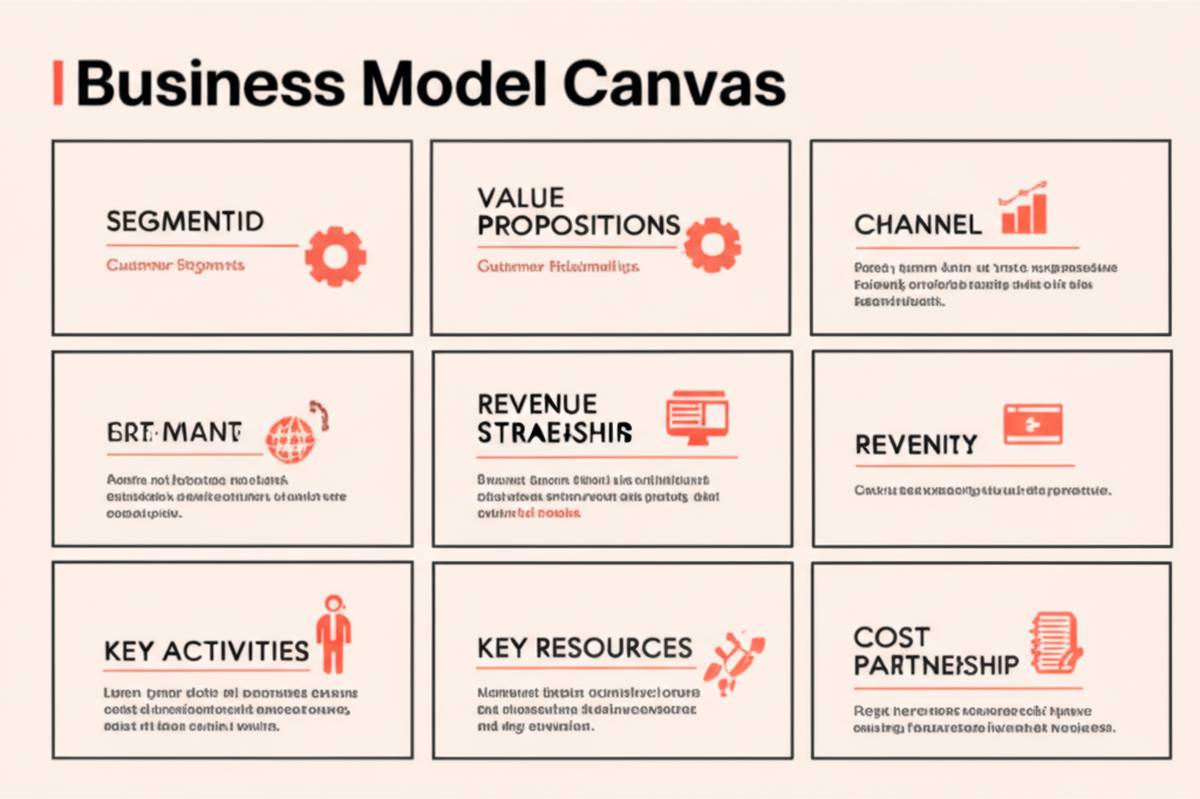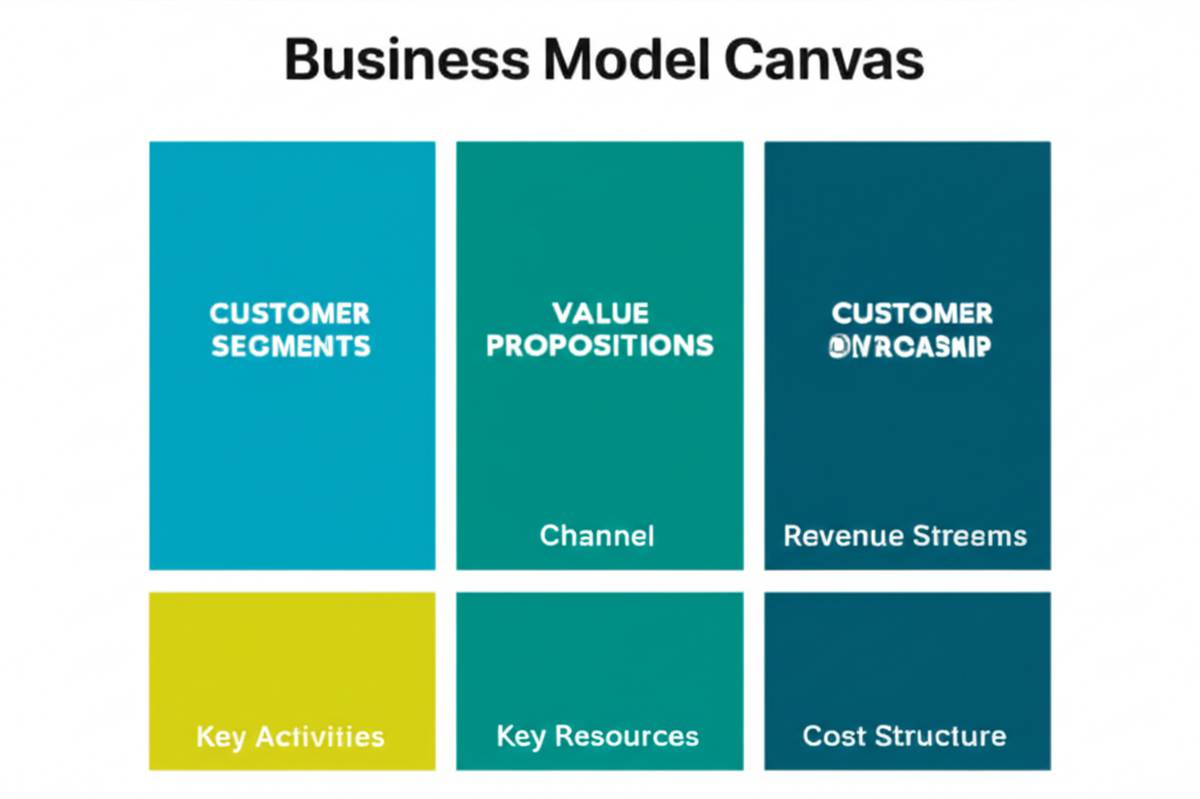Got a brilliant idea buzzing in your head but unsure how to transform it into a thriving startup? You’re not alone! Many aspiring entrepreneurs struggle with taking that initial leap. That’s where the Business Model Canvas comes in – a powerful, visual tool that simplifies the process of planning and validating your business. Let’s explore how you can use this canvas to map out your path to profitability and success. Welcome to Billionmode, your partner in wealth building. Check out Start Here to begin your journey!
What is the Business Model Canvas?
The Business Model Canvas is a strategic management and entrepreneurial tool. It allows you to describe, design, challenge, invent, and pivot your business model. Created by Alexander Osterwalder and Yves Pigneur, it provides a holistic view of your business in a single page, making it easy to understand and share with others. Think of it as a blueprint for your business, helping you visualize all the key components and how they interact. You can find more details about it on Wikipedia.
The Nine Building Blocks
The Business Model Canvas consists of nine essential building blocks. Let’s break them down one by one:
- Customer Segments: Who are you creating value for? Identify your target audience(s).
- Value Propositions: What value do you deliver to your customers? What problems are you solving?
- Channels: How do you reach your customers? What channels do you use for communication, distribution, and sales?
- Customer Relationships: What type of relationship do you establish and maintain with each customer segment?
- Revenue Streams: How do you make money from each customer segment? What are they willing to pay for?
- Key Resources: What key assets do you need to deliver your value proposition?
- Key Activities: What key activities do you need to perform to deliver your value proposition?
- Key Partnerships: Who are your key partners and suppliers?
- Cost Structure: What are the most important costs inherent in your business model?
Turning Your Idea into a Startup Using the Business Model Canvas
Now, let’s see how you can leverage the Business Model Canvas to transform your brilliant idea into a tangible, profitable startup. Remember, building wealth requires strategy and action. Learn more about Wealth Building on our site!
Step 1: Start with the Value Proposition
What problem are you solving, or what need are you fulfilling? Your value proposition is the heart of your business. It’s what makes your offering attractive to customers. For example, if you’re creating a meal-prep service, your value proposition might be “providing healthy, delicious, and convenient meals for busy professionals.”
Step 2: Identify Your Customer Segments
Who are you trying to reach with your value proposition? Be as specific as possible. Are you targeting busy professionals, students, families, or a niche group? Understanding your customer segments allows you to tailor your value proposition, channels, and customer relationships more effectively. Explore the importance of a Money Mindset for your startup’s success.
Step 3: Define Your Channels
How will you deliver your value proposition to your customers? This includes your marketing and sales channels, as well as your distribution channels. Will you use social media, online advertising, email marketing, or a physical store? How will customers receive your product or service? Consider a blended approach for maximum impact. Also consider exploring our Digital Income strategies for online reach.
Step 4: Determine Customer Relationships
What kind of relationship do you want to have with your customers? Will it be a personal relationship, a self-service relationship, or something in between? Think about how you’ll interact with your customers and provide support. Focus on building loyalty. You may also check our Blog for valuable tips.
Step 5: Outline Your Revenue Streams
How will you make money? This is where you identify all the different ways you’ll generate revenue from your customer segments. Will you sell products, offer services, subscriptions, or something else? Be clear about your pricing strategy and how you’ll capture value.
Step 6: Map Out Your Key Resources
What assets are essential to your business? This could include physical assets, intellectual property, human resources, or financial resources. Identifying your key resources helps you understand what you need to operate effectively. Learn about AI Automation to enhance efficiency.
Step 7: Define Your Key Activities
What are the most important things you need to do to make your business work? This could include activities like product development, marketing, sales, customer service, or operations. Focusing on key activities helps you prioritize your efforts.
Step 8: Identify Your Key Partnerships
Who do you need to partner with to make your business successful? This could include suppliers, distributors, or strategic partners. Building strong partnerships can help you access resources, reduce costs, and expand your reach.
Step 9: Calculate Your Cost Structure
What are the most significant costs in your business? This includes both fixed costs and variable costs. Understanding your cost structure helps you manage your finances effectively and ensure profitability.

Validating Your Business Model Canvas
Once you’ve completed your Business Model Canvas, it’s time to validate it. This means testing your assumptions and gathering feedback from potential customers. Don’t be afraid to iterate and make changes to your canvas as you learn more. The goal is to refine your model until you have a clear path to profitability. Discover strategies on Life Design to align your startup with your personal values.
Testing Your Assumptions
Every building block in your canvas is based on assumptions. To validate your model, you need to test these assumptions. For example, you might conduct customer interviews, run surveys, or launch a minimum viable product (MVP) to gather data and feedback.
Gathering Feedback
Solicit feedback from potential customers, industry experts, and other entrepreneurs. Ask them for honest opinions about your value proposition, pricing, channels, and other aspects of your business. Be open to criticism and use it to improve your model.
Iterating and Refining
Based on the feedback you receive, make adjustments to your Business Model Canvas. This is an iterative process, so don’t expect to get it perfect on the first try. Keep refining your model until you have a solid foundation for your startup. Also, remember to stay updated with Billionmode’s blog.
Benefits of Using the Business Model Canvas
- Clarity: Provides a clear and concise overview of your business model.
- Focus: Helps you focus on the most important aspects of your business.
- Collaboration: Facilitates collaboration and communication among team members.
- Flexibility: Allows you to easily experiment with different business models.
- Validation: Helps you validate your assumptions and reduce risk.
Ready to take your idea to the next level? Unlock the power of AI in your business with our comprehensive guide to AI Automation strategies!
🚀 Ready to Build Your Billionmode Empire?
Subscribe to our newsletter and get exclusive insights, strategies, and tools to help you build wealth, achieve freedom, and live a meaningful, impactful life. Don’t miss out – join the Billionmode community today!
Conclusion
The Business Model Canvas is an invaluable tool for turning your idea into a profitable startup. By systematically mapping out the nine building blocks, you can gain clarity, focus your efforts, and validate your assumptions. So, grab a canvas, gather your team, and start building your Billionmode success story today!
FAQ
What is the main benefit of using the Business Model Canvas?
The main benefit is that it provides a clear, concise, and visual overview of your entire business model on a single page. This makes it easier to understand, communicate, and iterate on your business strategy.
How often should I revisit and update my Business Model Canvas?
You should revisit and update your Business Model Canvas regularly, especially when you’re facing significant changes in the market, customer needs, or competitive landscape. Aim to review it at least quarterly, or more frequently if necessary.
Can the Business Model Canvas be used for non-profit organizations?
Yes, the Business Model Canvas can be adapted for non-profit organizations. Instead of focusing solely on profit, non-profits can use the canvas to map out how they create value for their beneficiaries and stakeholders, and how they generate the resources needed to sustain their mission.


